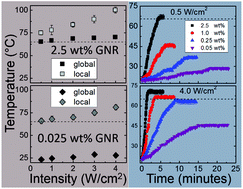Nanoscale steady-state temperature gradients within polymer nanocomposites undergoing continuous-wave photothermal heating from gold nanorods†
Abstract
Anisotropically-shaped metal nanoparticles act as nanoscale heaters via excitation of a localized surface plasmon resonance, utilizing a photothermal effect which converts the optical energy into local heat. Steady-state temperatures within a polymer matrix embedded with gold nanorods undergoing photothermal heating using continuous-wave excitation are measured in the immediate spatial vicinity of the nanoparticle (referred to as the local temperature) from observing the rate of physical rotation of the asymmetric nanoparticles within the locally created polymer melt. Average temperatures across the entire (mostly solid) sample (referred to as the global temperature) are simultaneously observed using a fluorescence method from randomly dispersed molecular emitters. Comparing these two independent measurements in films having varying concentrations of nanorods reveals the interplay between the local and global temperatures, clearly demonstrating the capability of these material samples to sustain large steady-state spatial temperature gradients when experiencing continuous-wave excitation photothermal heating. These results are discussed quantitatively. Illustrative imaging studies of nanofibers under photothermal heating also support the presence of a large temperature gradient. Photothermal heating in this manner has potential utility in creating unique thermal processing conditions for outcomes such as driving chemical reactions, inducing crystallinity changes, or enhancing degradation processes in a manner unachievable by conventional heating methods.



 Please wait while we load your content...
Please wait while we load your content...